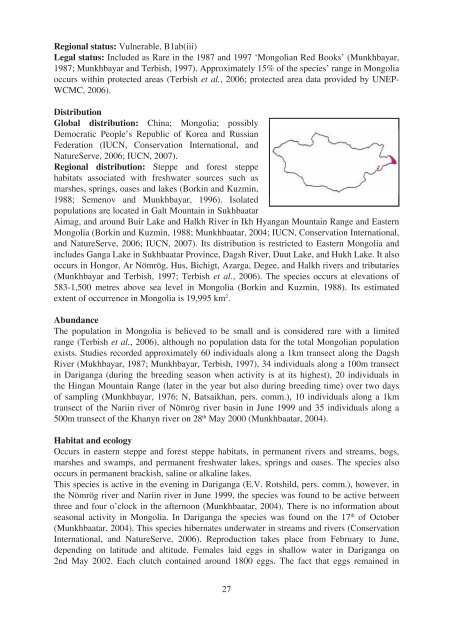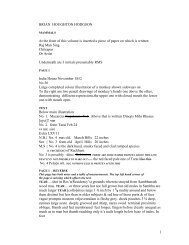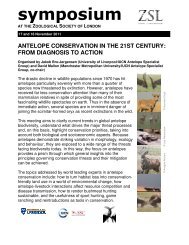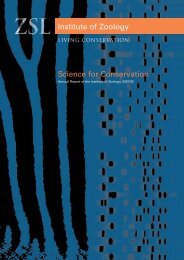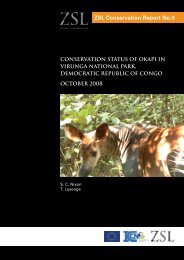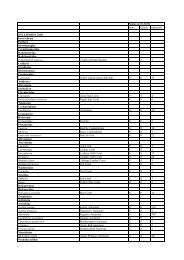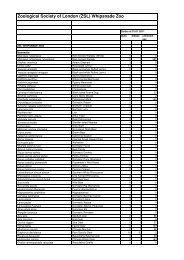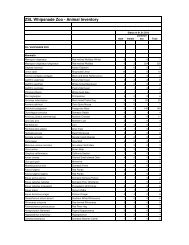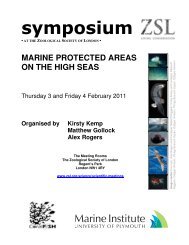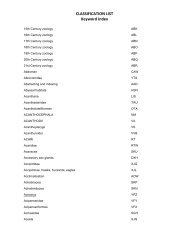Summary Conservation Action Plans for Mongolian Reptiles and ...
Summary Conservation Action Plans for Mongolian Reptiles and ...
Summary Conservation Action Plans for Mongolian Reptiles and ...
Create successful ePaper yourself
Turn your PDF publications into a flip-book with our unique Google optimized e-Paper software.
Regional status: Vulnerable, B1ab(iii)<br />
Legal status: Included as Rare in the 1987 <strong>and</strong> 1997 ‘<strong>Mongolian</strong> Red Books’ (Munkhbayar,<br />
1987; Munkhbayar <strong>and</strong> Terbish, 1997). Approximately 15% of the species’ range in Mongolia<br />
occurs within protected areas (Terbish et al., 2006; protected area data provided by UNEP-<br />
WCMC, 2006).<br />
Distribution<br />
Global distribution: China; Mongolia; possibly<br />
Democratic People’s Republic of Korea <strong>and</strong> Russian<br />
Federation (IUCN, <strong>Conservation</strong> International, <strong>and</strong><br />
NatureServe, 2006; IUCN, 2007).<br />
Regional distribution: Steppe <strong>and</strong> <strong>for</strong>est steppe<br />
habitats associated with freshwater sources such as<br />
marshes, springs, oases <strong>and</strong> lakes (Borkin <strong>and</strong> Kuzmin,<br />
1988; Semenov <strong>and</strong> Munkhbayar, 1996). Isolated<br />
populations are located in Galt Mountain in Sukhbaatar<br />
Aimag, <strong>and</strong> around Buir Lake <strong>and</strong> Halkh River in Ikh Hyangan Mountain Range <strong>and</strong> Eastern<br />
Mongolia (Borkin <strong>and</strong> Kuzmin, 1988; Munkhbaatar, 2004; IUCN, <strong>Conservation</strong> International,<br />
<strong>and</strong> NatureServe, 2006; IUCN, 2007). Its distribution is restricted to Eastern Mongolia <strong>and</strong><br />
includes Ganga Lake in Sukhbaatar Province, Dagsh River, Duut Lake, <strong>and</strong> Hukh Lake. It also<br />
occurs in Hongor, Ar Nömrög, Hus, Bichigt, Azarga, Degee, <strong>and</strong> Halkh rivers <strong>and</strong> tributaries<br />
(Munkhbayar <strong>and</strong> Terbish, 1997; Terbish et al., 2006). The species occurs at elevations of<br />
583-1,500 metres above sea level in Mongolia (Borkin <strong>and</strong> Kuzmin, 1988). Its estimated<br />
extent of occurrence in Mongolia is 19,995 km 2 .<br />
Abundance<br />
The population in Mongolia is believed to be small <strong>and</strong> is considered rare with a limited<br />
range (Terbish et al., 2006), although no population data <strong>for</strong> the total <strong>Mongolian</strong> population<br />
exists. Studies recorded approximately 60 individuals along a 1km transect along the Dagsh<br />
River (Mukhbayar, 1987; Munkhbayar, Terbish, 1997), 34 individuals along a 100m transect<br />
in Dariganga (during the breeding season when activity is at its highest), 20 individuals in<br />
the Hingan Mountain Range (later in the year but also during breeding time) over two days<br />
of sampling (Munkhbayar, 1976; N, Batsaikhan, pers. comm.), 10 individuals along a 1km<br />
transect of the Nariin river of Nömrög river basin in June 1999 <strong>and</strong> 35 individuals along a<br />
500m transect of the Khanyn river on 28 th May 2000 (Munkhbaatar, 2004).<br />
Habitat <strong>and</strong> ecology<br />
Occurs in eastern steppe <strong>and</strong> <strong>for</strong>est steppe habitats, in permanent rivers <strong>and</strong> streams, bogs,<br />
marshes <strong>and</strong> swamps, <strong>and</strong> permanent freshwater lakes, springs <strong>and</strong> oases. The species also<br />
occurs in permanent brackish, saline or alkaline lakes.<br />
This species is active in the evening in Dariganga (E.V. Rotshild, pers. comm.), however, in<br />
the Nömrög river <strong>and</strong> Nariin river in June 1999, the species was found to be active between<br />
three <strong>and</strong> four o’clock in the afternoon (Munkhbaatar, 2004). There is no in<strong>for</strong>mation about<br />
seasonal activity in Mongolia. In Dariganga the species was found on the 17 th of October<br />
(Munkhbaatar, 2004). This species hibernates underwater in streams <strong>and</strong> rivers (<strong>Conservation</strong><br />
International, <strong>and</strong> NatureServe, 2006). Reproduction takes place from February to June,<br />
depending on latitude <strong>and</strong> altitude. Females laid eggs in shallow water in Dariganga on<br />
2nd May 2002. Each clutch contained around 1800 eggs. The fact that eggs remained in<br />
27


